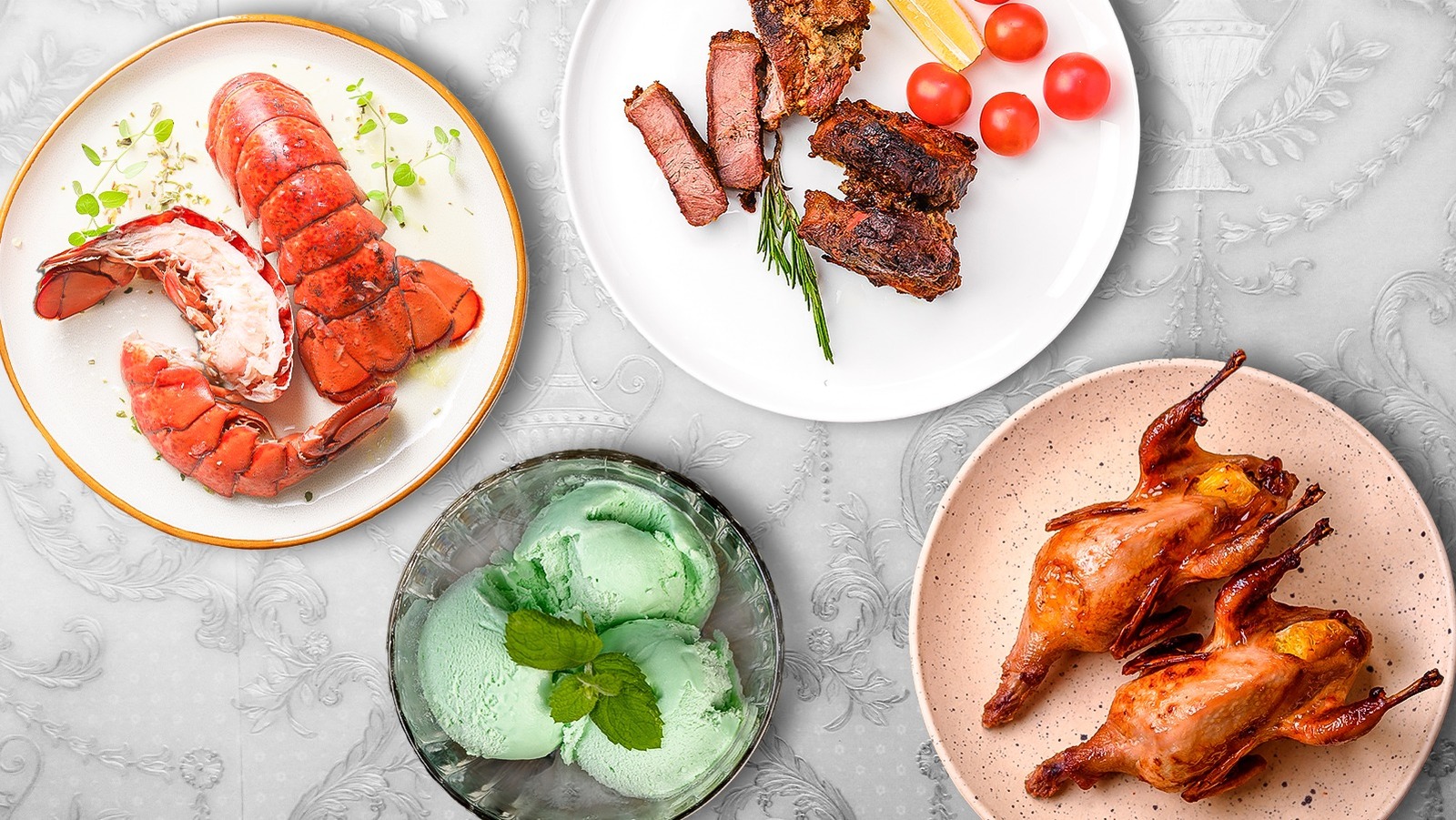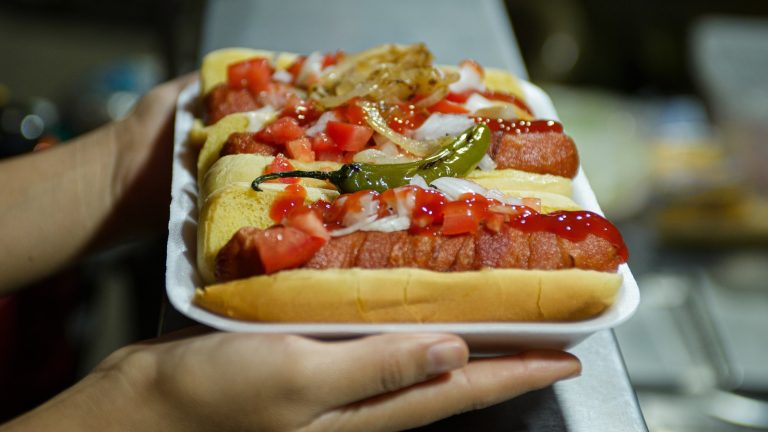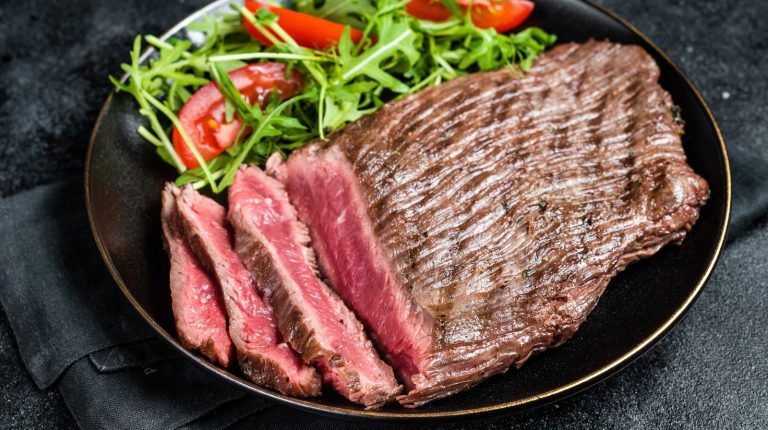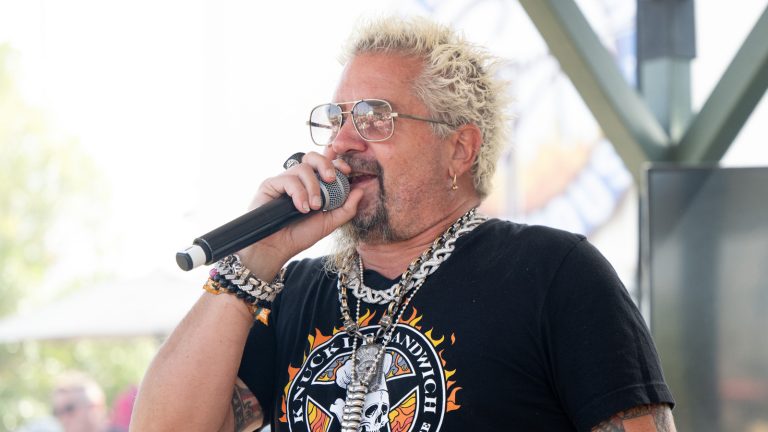The lives of the royals have been a cultural phenomenon for centuries. Even if you don’t keep up with the latest news about the royal families, it’s nearly impossible to avoid seeing photos or reading headlines about them. Whether it’s a montage of Prince William’s children on the cover of a magazine by the grocery store checkout line, or a social media alert about Meghan Markle’s new Netflix show from a website you don’t remember subscribing to, we all know at least a little bit about royal families. One phenomenon that, when it happens, covers news feeds and magazines around the world is a royal wedding.
There’s something about the royal lifestyle that is fascinating to people, and when there’s a wedding, we have the chance to see the extravagance of royalty in full force. From the gowns to the protocols to the decor, royal weddings showcase the decadent lifestyles of the elite. Royal wedding menus are no exception. Expensive Champagne, towering wedding cakes, and even fish caught mere hours before it hits the plate are just some of the meals enjoyed by monarchs and their guests. We looked at royal wedding menus throughout history to find the one menu that can take the crown.
Queen Victoria and Prince Consort Albert
One of the United Kingdom’s most notable monarchs, Queen Victoria, reigned for close to 64 years, shaping the monarchy’s reputation with the public from one consumed by opulence to a position focusing on public service. With the second-longest reign in Britain’s history, Queen Victoria also shaped the nation by establishing new traditions and expanding the reach of the British Empire. On Queen Victoria’s wedding day in 1840, the then-20-year-old queen opted to wear a large white gown. Typically, women would wear their Sunday best for wedding ceremonies, but the queen’s unique move began the long-standing tradition of brides in white gowns that still persists today.
At her and Prince Consort Albert’s wedding reception, guests enjoyed an array of dishes. From macaroni timbale, a layered pasta dish, to broiled turbot with lobster sauce, there were options for various palettes. Raised game pie was also served, this one in particular filled with pigeon meat and adorned with pigeon feet jutting from the middle for extra flair.
However, the ultimate showstopper of the night was Queen Victoria and Prince Albert’s wedding cake, a three-tiered fruit cake topped with figurines of the bride and groom. The cake stood 9 feet tall and weighed more than a whopping 300 pounds. In case this wasn’t enough for guests, smaller cakes were baked as well to send slices to those unable to attend the affair. Following the reception, wedding cakes became more popular throughout the nation.
King George V and Queen Mary
King George V was born during the reign of his grandmother, Queen Victoria. He was wed on July 6, 1893, when he was still a prince, years before he eventually took the throne in 1910. His marriage to the then-Princess Victoria Mary of Teck (later, Queen Mary) followed the traditions set by his maternal grandmother, Queen Victoria. The then-princess wore a white wedding gown, and the couple was married at Chapel Royal at St James’s Palace, the same location as Queen Victoria’s wedding. Queen Victoria hosted a royal breakfast at 2:30 p.m. following the ceremony. She spared no expense on her grandson, serving up a 17-course menu for the couple.
There were some flavorful meat dishes, like braised lamb cutlets that were baked in an Italian sauce, which was made from ham, mushrooms, and herbs, and then topped with artichoke hearts. Chicken dishes included fattened chicken in watercress cream and shredded chicken tossed in a chive vinaigrette with mayonnaise, lettuce, and cucumber. There was also a variety of vegetable courses, from creamed cauliflower and asparagus soup to green beans or spinach. Aspics, or meat jellies, were a prominent menu feature, as well, with cold ham, cold tongue, and calf liver terrine, all set in aspic jellies.
However, some of the most unique dishes on this wedding menu include a consommé made with rooster’s combs and kidneys, as well as duckling breast (yes, from an actual baby duckling). The latter dish was cooked in white wine with peas and pearl onions.
King George VI and Queen Elizabeth The Queen Mother
Then-Prince Albert, who became King George VI, was the second son of King George V, and therefore wasn’t first in line for the throne. Since he wasn’t anticipated to be king, his wedding was more toned down than those of other British monarchs. However, a royal wedding is still a royal wedding, and a bit of extravagance is guaranteed. Albert and Elizabeth Bowes-Lyon (later known as Queen Elizabeth The Queen Mother) decided to hold their marriage ceremony on April 26, 1923, in Westminster Abbey instead of the royal chapel at St James’s Palace, where Albert’s father was married.
The pair still had a traditional royal breakfast, serving up dishes adorned with royal names, like Prince Albert lamb cutlets or choice cuts of salmon named after Queen Mary. Meat jellies were back on the menu again, featuring an aspic with ham and tongue. Other dishes included Scottish-style capons (a castrated male chicken), asparagus in cream, and a royal salad.
For dessert, strawberries and cream were served along with coffee — but the real showstopper was an elaborate wedding cake that towered over guests, reaching 10 feet high. The cake featured detailed reproductions of notable royal locations, like Windsor Castle and St. George’s Chapel. The cake was put on display for the public to see following the wedding.
Queen Elizabeth II and Prince Philip
The longest-reigning monarch in British history, Queen Elizabeth II reigned for over 70 years from 1952 to 2022, taking the throne when she was just 25 years old. During World War II, the British government implemented strict food rationing measures due to a national food shortage. When the then-Princess Elizabeth got married to Lieutenant Philip Mountbatten (aka Prince Philip) in 1947, food rationing was still in place. The couple’s wedding breakfast menu reflected this, with their wedding cake made from overseas ingredients. With ingredients donated by the Australian Girl Guides, for example, the wedding cake was composed of fruit cake and featured four tiers, with the full display weighing 500 pounds.
The wedding breakfast had 150 attendees and was hosted at Buckingham Palace in the Ball Supper Room. The first course, named filet de sole Mountbatten, was a filleted fish dish named after the Mountbatten family, as is typical in royal wedding menus. Other dishes included partridge in casserole, green beans, a salad, and fried potato balls, or pommes noisette.
The dessert course featured a spherical ice cream dessert that was called bombe glacée Princess Elizabeth friandises. This ice cream dish had strawberries in it, which were actually out of season in November, at the time of the wedding.
Then-Prince Charles and Princess Diana
Not only was the 1981 wedding of then-Prince (and future King) Charles and then-Lady Diana Spencer declared a public holiday in the United Kingdom, but it was also commonly coined the “wedding of the century.” This royal wedding was televised to over 750 million people from over 74 countries, and more than 600,000 people filled the London streets to witness the event in person. Although millions tuned into the event, only a lucky 120 guests scored invites to the wedding breakfast reception held at Buckingham Palace.
Those guests enjoyed dishes like quenelles de barbue cardinal, which is a dish similar to a dumpling made with a type of flatfish called brill and served in a lobster sauce. The main course was the Princess of Wales chicken, dubbed as such in typical royal fashion. The Princess Diana-inspired dish featured chicken filets stuffed with a fine lamb mousse. Fresh strawberries, which were in season during the July nuptials (unlike those at Queen Elizabeth II’s wedding reception), were served with dollops of clotted cream.
But the real highlight of Charles and Diana’s wedding menu was the cake. The royal couple actually served 27 different wedding cakes for their guests, aside from the official cake, which took the baker about three-and-a-half months to construct. This main cake was a fruit cake, which you may have noticed is typical in royal weddings. It stood 5 feet tall and featured both the Spencer family crest and Charles’ coat of arms, along with a variety of flowers. Decades later, a slice of frozen cake from this night sold at auction for around $2,450 in 2021.
King Felipe VI and Queen Letizia
The royal family of Spain has an extensive history, with the House of Bourbon ruling on and off for over 300 years. King Felipe VI of Spain was wed in 2004 to Letizia Ortiz Rocasolano. The future-Queen Letizia grew up in a middle-class family and worked her way up in the journalism field, before hitting it off with Felipe at a mutual pal’s dinner party. Felipe, who at the time was known as the Prince of Asturias, married Letizia at Madrid’s Almudena Cathedral. It was the first royal wedding to be held in the city of Madrid since the marriage of Felipe’s great-grandparents nearly a century prior. The highly anticipated royal wedding was televised to millions of people around the world, while locals filled the streets hoping to catch a glimpse of the newlyweds.
After the ceremony, a banquet was held at the Royal Palace. Guests dined on appetizers like breaded scallops, Jabugo ham, and croquettes. The first course included puff pastry tartlets with seafood on a bed of vegetables. This was followed by thyme-seasoned roast capon and nuts. Needless to say, the main event was the elaborate dessert course designed by the renowned Spanish pastry chef Francisco Torreblanca. The dessert was organized on a curved and tiered stand that reached 13.5 feet in height. This decadent final dish was flavored with dark chocolate, sweet chocolate, and olive oil biscuits.
Prince William and Kate Middleton
The April 2011 royal wedding of Prince William and Kate Middleton (aka Catherine, Princess of Wales) was a large spectacle with nearly 2,000 guests in attendance. Celebrity guests like Sir Elton John and David Beckham were present at the Westminster Abbey ceremony, which the press also called the “wedding of the century,” but only the royal couple’s close family and friends enjoyed the post-wedding meal held at Buckingham Palace. The newlyweds’ menu emphasized local British produce.
The first course featured marinated South Uist salmon, Lyme Bay crab, and wild Hebridean langoustines, along with a fresh herb salad. All of these ingredients were sourced in areas across the United Kingdom. Providing a personal touch to the meal, the vegetables featured in the following course were harvested at then-Prince Charles’ Scottish estate. This course included dishes like a saddle of North Highland Mey Select organic lamb, Highgrove spring vegetables, English asparagus, Jersey Royal potatoes, and sauce Windsor.
Aside from cake, the final course included Berkshire honey ice cream, sherry trifle, and chocolate parfait. Each course was accompanied by a wine pairing to highlight the dish. Finally, William and Kate’s main wedding cake was smaller than that of previous royal couples, standing at just 3 feet. This fruit cake, however, was adorned with over 900 intricate details and had eight tiers.
Sovereign Prince Albert II and Princess Charlene
Monaco, a sovereign principality that sits on the Mediterranean Sea, is roughly the size of New York City’s Central Park and has a royal family known as the House of Grimaldi. The family has ruled the principality for over 700 years. In July 2011, Sovereign Prince Albert II of Monaco married Charlene Wittstock (later known as Princess Charlene), a former professional swimmer for the South African Olympic swim team. After the couple’s wedding ceremony, a multi-course gala was held for around 450 guests, with meals prepared by French-born chef Alain Ducasse.
While the event featured South African red wine as a nod to the princess, as well as French Champagne, pretty much everything else on the menu was curated with local ingredients sourced within six miles of Monaco. Prioritizing a sustainable and ethical menu, then, the courses began with a fillet of mullet and vegetable medley, the layout of which resembled the Riviera’s landscape. The vegetables were harvested mere hours beforehand at Albert II’s personal farm, some of which were tomatoes, zucchini, and peppers. The fish was also line-caught on the same day.
Fresh fruit was served for dessert, and honey was sourced from Monaco’s urban beehives. With this wedding menu, the Prince and Princess of Monaco took farm-to-table to a whole new level.
Princess Madeleine and Christopher O’Neill
Princess Madeleine, the second child of King Carl XVI and Queen Silvia of Sweden, spent years living in the U.S. and U.K., and in June 2013, she married a British-American businessman named Christopher O’Neill. The couple got married in Stockholm, Sweden at Slottskyrkan, the Palace Church, and while O’Neill decided not to claim royal titles in order to maintain his U.S. and U.K. citizenship, their wedding was still as lavish and elegant as ever. For example, the bride wore a Valentino gown with silk, lace, and a 13-foot-long train.
After the ceremony, the newlyweds rode in a procession through the city and then took a boat to Drottningholm Palace to join their guests for the wedding dinner. The menu emphasized Swedish cuisine and included many local delicacies like kalix löjrom, small fish roe harvested in Northern Sweden, which was served with crème fraîche. Butter-baked trout was also on the menu, served with three types of asparagus (steamed white, fried green, marinated violet), along with a tomato-shallot compote with browned butter, horseradish, chive oil, and salmon roe. A mustard-seasoned local fillet of veal was also served with an Astrakan cider sauce.
The dessert course featured a pavlova with strawberry sorbet, strawberry ice cream, and white chocolate. Fresh wild strawberries were added to top it off.
Princess Märtha Louise and Durek Verrett
The wedding of Norwegian Princess Märtha Louise to Californian and self-proclaimed shaman Durek Verrett was not without controversy. The wedding, which took place in Geiranger, Norway in August 2024, was a multi-day event with a night of welcome drinks, a pre-wedding party, the wedding itself, and then breakfast and brunch the following morning. Their 350 guests were reportedly advised not to share any photos from the wedding events online, as the couple signed exclusive deals with Hello! magazine and Netflix.
For our purposes, another alleged unconventional choice by the bride and groom was to give out drink vouchers at the Hotel Union, where the reception was held, rather than offer the typical open bar that is common in Norwegian weddings. Guests then had the option to buy cocktails made with a commemorative gin launched in the couple’s honor in collaboration with Oslo Håndverksdestilleri. Since she’d renounced her official royal duties two years prior, the alleged commercial use of Märtha Louise’s royal title on the bottle was previously subjected to an investigation.
Aside from the controversies, the wedding menu itself included an array of options, some with Norwegian influence, and others drawing from Italian cuisine. The menu included Norwegian crayfish with lemon, monkfish brushed with rosemary and garlic, and garganelli pasta with piquillo peppers, eggplant, and pine nuts. Pinsa Romana, an Italian flatbread, and a carrot cilantro salad with yellow raisins, served as lighter bites. The dessert showcased a variety of different cakes, with the main event being a five-tier carrot cake, which took more than a week to make.
Prince Harry and Meghan Markle
Don’t worry, we didn’t forget about the Duke and Duchess of Sussex. If there’s one wedding menu that is sure to impress, it’s Prince Harry and Meghan Markle’s. It’s no secret that Duchess Meghan has a passion for the culinary world. Her former lifestyle blog, The Tig, along with her more recent Netflix show, “With Love, Meghan,” has showcased her love for cooking, gardening, and all things entertainment-related. After she and Harry tied the knot on May 19, 2018, at St George’s Chapel in Windsor, they headed to a luncheon hosted by Queen Elizabeth II at Windsor Castle, where hundreds of guests, including Oprah Winfrey and George Clooney, were served a variety of handheld foods.
Some notable bites included Scottish langoustines wrapped in smoked salmon with citrus crème fraîche, garden pea panna cotta with quail eggs and lemon verbena, and a croquette of confit Windsor lamb with roasted vegetables and shallot jam. The heartier canapes included a 10-hour slow-roasted Windsor pork belly with apple compote and crackling, plus a fricassee of free-range chicken with morel mushrooms and young leeks.
The thought-out and complex luncheon menu also featured an elderflower wedding cake, flavored with elderflower syrup made from trees at one of Queen Elizabeth II’s estates. It was also used in an apple elderflower mocktail for those looking for a refreshing nonalcoholic beverage. Champagne was also served alongside pistachio macaroons, orange crème brûlée tartlets, and rhubarb crumble tartlets. More delicious food was enjoyed at an evening reception at Frogmore House hosted by then-Prince Charles.
On their big day, Harry and Meghan’s wedding menus were jam-packed with curated flavors for diverse palettes. The variety of dishes and the use of local ingredients put this royal menu in the top spot.




